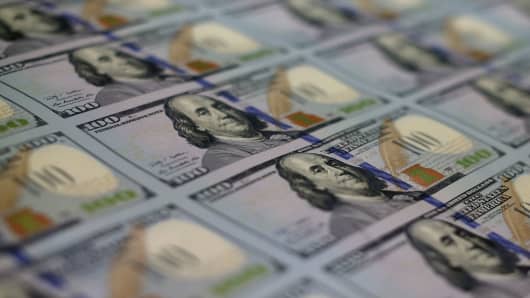"It's been in a serious funk," said Boris Schlossberg, BK Asset Management managing director, foreign exchange strategy. He says there are other factors at play against the dollar, including improving economic prospect for the U.K. and Europe, and a risk aversion to Japan.
In the last week alone, the dollar has lost two percent against the yen. "This has been the stealthy blowup of the summer. The consensus on dollar/yen being a one way trade to the upside has gotten hammered," said Schlossberg. "The whole 'Abe-nomics' story has really reached its peak. There's nothing new. The Bank of Japan is doing nothing. There's no additional stimulus…There's some turbulence in the Nikkei, which was down four percent earlier this week. Dollar/yen is also getting hammered because U.S. yields are not responding to tapering, and on the Japanese side, because of risk aversion."
Schlossberg said the euro has also moved close to an important technical area, on signs of 'green shoots' in the euro zone. "Right now, the battle is for 1.34. That's really where everybody is watching to see if it can blast through that level. The other thing that's happening is it's summer time, and in relatively thin markets, some of the moves could be getting exaggerated," he said. Schlossberg said if the euro breaks 134.15, it could challenge the year high of 137.10.
(Read more: Fed hawks and doves align; tapering imminent)
Jens Nordvig, global head of G-10 foreign exchange strategy at Nomura Securities, said he thinks the dollar's downward move is coming to an end. He also said the Fed is behind the decline. "I think the most important explanation is the Fed has managed to distinguish between tapering and raising rates. Initially, the dollar got support from talk about tapering and short rates went up," he said.
"I don't think the dollar is going to continue going down. We' re in the middle of what I would call final capitulation. People have been trying to get long dollar and it hasn't been working, and now people are really giving up," Nordvig said.
Nordvig said he has a model that looks at dollar moves, taking into accounts rates in different parts of the curve and foreign rates, and he also has a component for unexplained moves. "Today the unexplained component was huge. The dollar is too weak relative to everything," he said. "This was one of the biggest unexplained days in the last several years. This typically happens when people throw in the towel."
(Read more: Heeere's Bernanke: Will the Fed Finally Get specific?)
Nordvig said the dollar also weakened as short term rates moved back down over the last several weeks. "The U.S. data is improving. We actually had U.S. data going higher, and short rates going lower," said Nordvig. " Eventually we'll have an underlying trend of dollar strength… I think we might have around one more week of this type of capitulation. I would say come September, the dollar will be trading stronger."
The Fed is also influencing the dollar in another way. Nordvig said when a replacement is named for Bernanke, the market will assess the candidate and may need to adjust. "I don't think there's really a consensus at the moment," he said. The street had expected Vice Chair Janet Yellen to replace Bernanke, but President Obama has mentioned former Treasury Secretary Larry Summers and former Fed Gov. Donald Kohn as candidates. "I don't think we have a strong view. If we were to get some kind of news report that it's Summers, that would have to be priced in, and I think that would be dollar supportive," he said.
Summers is seen as someone who might wind down easing sooner than Yellen, who is viewed as dovish and similar to Bernanke in her views. Nordvig also said there is an issue of transparency at the Fed. Bernanke has stressed transparency and has made great efforts to communicate Fed policy, but Summers may feel differently and the markets would have to process that, he added.
(Read more: Why the Fed Will Try to Calm Market Nerves)
The dollar is also weakening into what some Treasury strategists see as a bullish time for bonds, meaning yields could decline further. CRT Capital chief Treasury strategist David Ader said it would not be surprising to see the 10-year yield at 2.3 percent in the near future. The 10-year yield Thursday was at 2.58 percent, off its recent high of 2.75 percent.
Stocks had their first up day in four days Thursday, with the Dow up 27 at 15,498 and the S&P 500 at 1697, up six.
Markets Friday will be watching wholesale trade at 10 a.m. ET.





